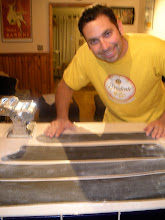So I had a conversation the other day with one of my friends about *surprise* fresh pasta. Basically, it turned in to a mini history lesson, coupled with a brainstorming session for the next market; and if not for our accompanying beer, would put many to sleep. And then, it happened. The obligatory
eureka moment that always seems to find itself on a bar stool. My friend assumed that he was on to something great, something monumental. You could see the idea surfacing in a combination of excitement and deep thought. I immediately stopped talking and waited for his genius to slide off his tongue.
"Wait, wait, wait, wait. I got it. I got it. Seriously," he interrupted. "Nobody is doing this. I mean, no body. It's your in."
"Alright, what?" I asked intriguingly.
"Flavored pasta," he said matter-of-factly. He leaned back and grabbed his beer seeing it safe to sip as it was clearly my turn to comment and take that ball of fire and run with it.
"Flavored pasta?" My brows furrowed.
"Shit yeah. You said you were going to use some buckwheat flour, why stop there? Seriously. Throw some cayenne pepper in there, tumeric, curry, herbs. Whatever. Right!?" Still excited. I'm not.
"Yeah, but, cayenne pepper and --"
"And then combine all of those flavors. Hell, you could do a mexican-themed market for cinco de mayo! Then another country for their festival!"
The ideas continued to billow out - similar to when you boil milk for a beciamella and forget that it's still on the stove and it boils over making that scary
hissing making you jump out of your chair thinking something's on fire. That's how excited I was.
Now, for fear of sounding "holier-than-thou" I need to say that the idea of flavoring pasta (as mentioned earlier) is a great one first and foremost. I stated in a previous post how I applaud people pushing the envelope, but I'm too tied to the traditional methods and lore surrounding "pasta." There are even a couple fresh pasta places in New England that I know of making obscurely flavored pasta.
(Here's where I play Debbie-Downer)
I hate that. I think it's bunk. It's bush-league. These flavors simply do not exist in traditional pasta. It does not even excite me for a fleeting moment. Whenever I see the myriad of flavors at these pasta stores, I basically want to throw them off of the shelves and explain to an innocent employee why these should not be here. Now here's the one caveat - if someone is not interested in the Italian pasta-making methods and really shows that they are not an Italian market place, then sure, make all the flavored pasta you want. Enjoy it with some salsa, mole, soy sauce, fish sauce, mayonnaise, or whatever. Have fun.
But we here at Ancora Pasta frown -- no, we grow angry -- no, no, no, we grow bellicose at the idea of this. We will continue flavoring pasta with only traditional accurate ingredients. Take the last market for instance. We sold
trofie (has wheat bread mixed in the dough) and
strascinati (saffron). Next market, we'll have some Maine-grown buckwheat flour in the dough as Italians love a hearty, nutty flour in their dough in the winter. Here are some other common ingredients mixed in traditional Italian pasta dough:
potato (gnocchi, trofie, and many many more)
parmigiano (garganelli - also uses nutmeg)
pig's blood (mostly northern areas - known as "pasta al sangue")
various flours
lard
spinach
milk
white wine
walnut oil (and other nuts)
nettles
As you can see, there are no Asian nor Mexican spices to be found. Call me boring. Give me a nice yolk-rich pasta with doppio 0 farina and some of nonna's sauce and I'm a happy man.











